Khách hành hương thật
sự kinh ngạc
khi nhìn thấy quang cảnh
đầu tiên qua cửa sổ
xe buýt với chiều
cao của pho tượng
nổi bật
trên cánh rừng,
quang cảnh giống
như một
cảnh ở
trong phim, thật là tuyệt vời.
Sau
khi trả lệ
phí vào cổng (1000 yên), tôi lại
ngạc nhiên một
lần nữa
khi đến gần
tượng đài. Đã
có một số
người đang chiêm ngưỡng,
họ cố gắng ngước
cổ nhìn lên pho tượng một
cách không bình thường, vì tượng đài quá cao.
Pho tượng
cao 120 mét, tôn trí trên một pháp tòa và đài sen, (trước
đây tượng
Nữ
Thần Tự
Do
được
xem là cao nhất thế
giới cũng
chỉ cao 93 mét).
Cánh tay trái của
Đức Phật
dài 18 mét, khuôn mặt
dài 20 mét, hai tai dài 20 mét và miệng
rộng 4 mét. Tổng
cộng tượng
nặng 4000 tấn.
Bên trong pho tượng có một
chiếc thang máy
cao 85 mét. Con người
ở dưới
tượng đài được
nhìn thấy như
những hạt
đậu nhỏ.
Có bốn tầng
dùng làm nơi quan sát, các tầng
còn lại là nơi
để các tăng
sĩ viết
kinh, dịch kinh, tụng
kinh... đặc biệt
có một phòng lớn
dùng để tôn trí
3000 tượng Phật.
Các
phòng bên trong không được rộng
rãi như hình ảnh
người ta trông thấy
ở bên ngoài vì phần
lớn của
khoảng không gian bên trong đã bị choáng hết
bởi các khung kiềng
sắt thép.
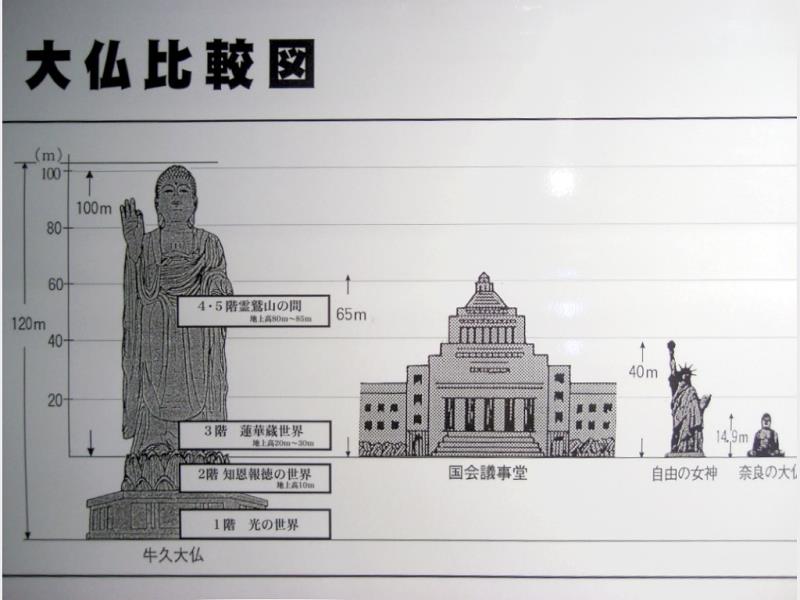
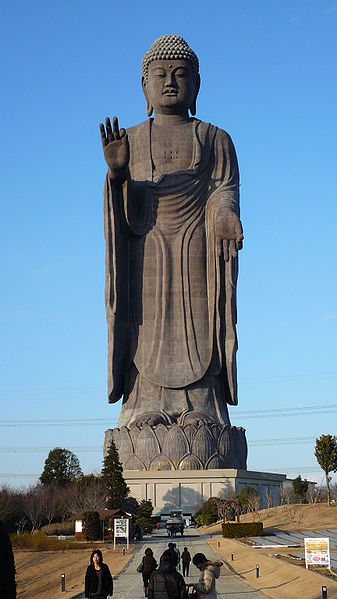
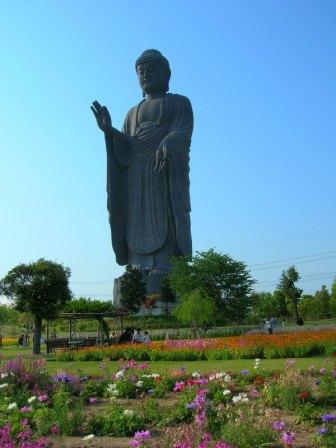
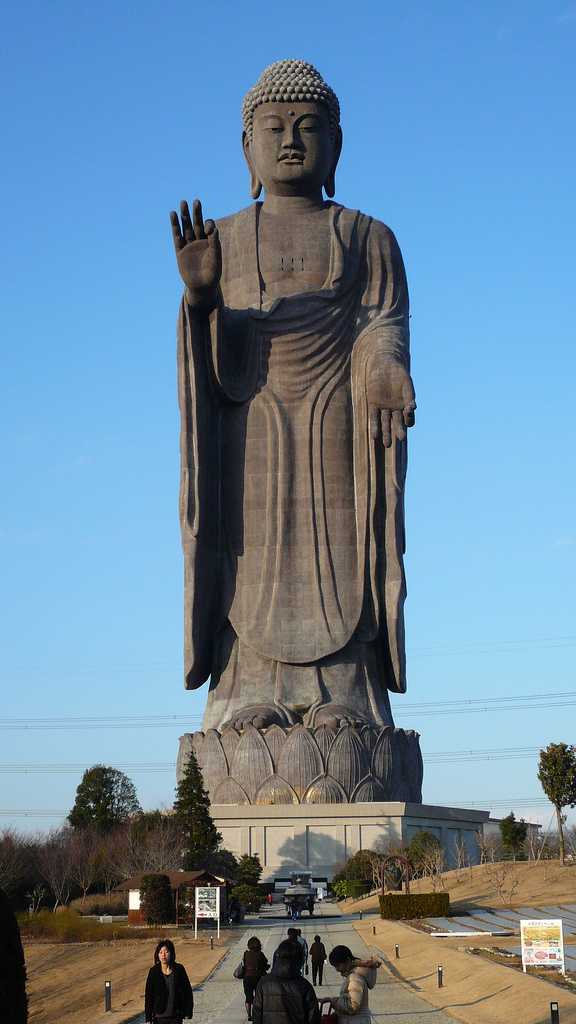
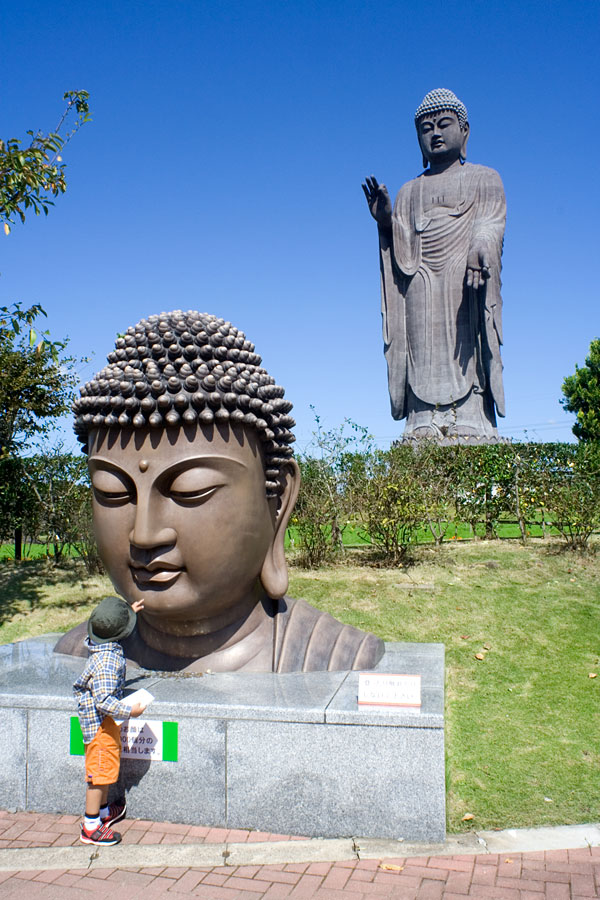
Công trình tạo tượng
này được khánh
thành sau 5 năm
thi công. Nói về mục
đích kiến tạo
pho tượng lớn
nhất thế
giới này, chủ công
trình tôn tạo này, Hòa Thượng
Yoshiyuki đã giải
thích và nhấn mạnh
đến chiều
kích lớn của
Đức Phật
như sau:
“Thật
ra Đức Phật
vĩ đại
hơn nhiều
so với pho tượng
này, sự to lớn
đó chúng ta không có đủ
khả năng
để giải
thích hoặc làm gì cho xứng
đáng. Thực tế,
tôn giáo không tùy thuộc
vào phạm vi
ở bề
ngoài để tương
hợp với
sự hiểu
đạo. Tuy nhiên,
tôn giáo ngày nay có khuynh hướng
coi trọng về
hình thức bên ngoài. Vì thế,
mục đích của
chúng tôi là để
cho mọi người
cảm thấy
và nhận ra được
sự quý báu trong lời
dạy của
Đức Phật
và cả một
khối lượng
khổng lồ
của giáo pháp nhà
Phật”.
Nhiều
người bị
gây ấn tượng
bởi chiều
kích của pho tượng
có lẽ sẽ
quan tâm đến giáo
lý Đạo Phật.
Có khoảng 500.000
người đến
viếng mỗi
năm, phân nửa
con số này không
phải là Phật
tử. Phần
lớn du khách đến đây từ
nhiều quốc
gia ở Đông
Nam Châu Á, nơi Phật
Giáo được xem là
tôn giáo chính của
họ.
Thích
Nguyên Tạng
Theo
W. Mukai, Pacific Friend, 05/95
(Tài liệu
do Tổng Lãnh sự
Nhật Bản
tại Sài gòn cung cấp).
Tu Viện
Quảng Đức
sẽ tổ chức hành hương viếng thăm tượng đài
Phật A Di Đà này vào tháng 4
năm 2011,
xem lịch trình
hành hương
chi tiềt.
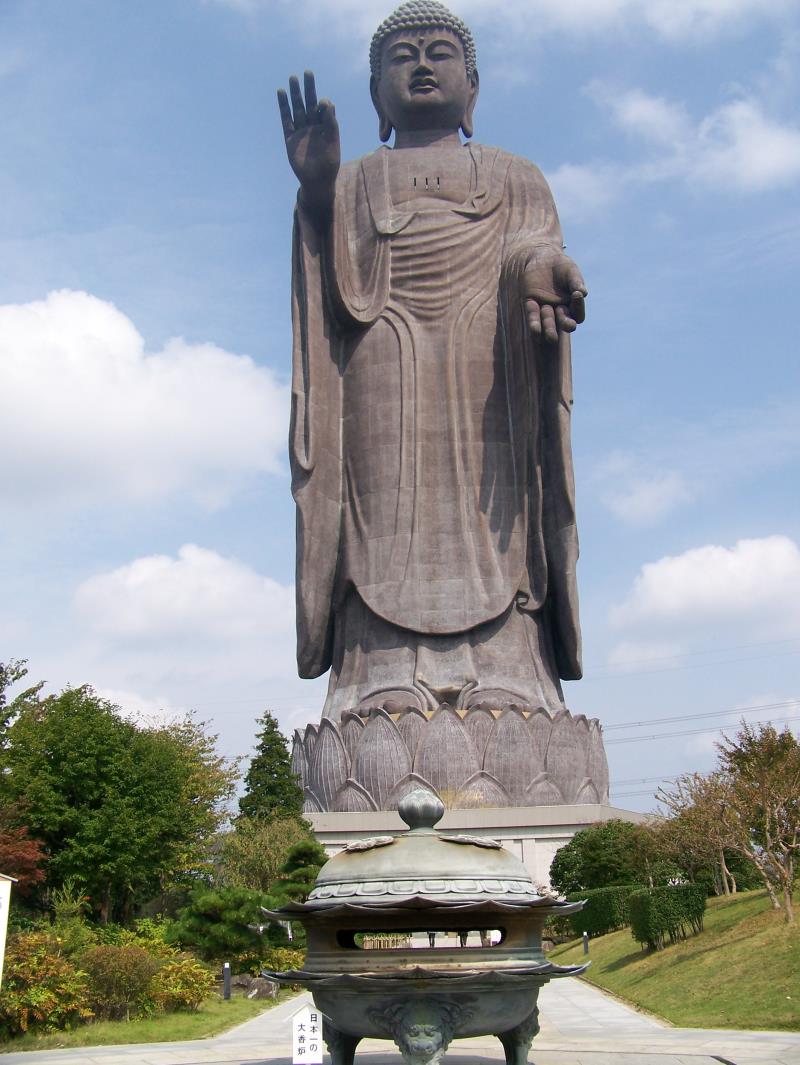
Ushiku Daibutsu
(The big Buddha of Ushiku)
Aurélien Baron,
International Affairs Division
Construction time:
10 years.
Recognized as: the
tallest Buddha in the entire world (in the Guinness Book from 1995)
"In Ushiku, this
Daibutsu(大仏)stands
magnificently with its 120 meters height."
What? You said 120
meters? Come on, you must be kidding. This would be 3 times as big as
the Statue of Liberty. And yet, it does look incredibly big. But somehow
it looks like another Buddha I think I saw somewhere else. Yes, it has a
great resemblance with its much smaller model in Asakusa(浅草),
at the Nishi-Honganji(西本願寺).
How could they
achieve this gigantic Daibutsu in just 10 years? In Europe they needed
decades and almost a century sometimes to build a church. Modern
techniques are indeed incredible. They made a steal frame, then affixed
6,000 bronze squares, 6 millimeters thick (you read well! MILLIMETERS)
and 4×4 meters wide. This is no hand-made job as you can imagine, cranes
were used to lift the heavy squares (more than 150 kilos each) and
assemble them together. The "final product" is Japanese but for the
anecdote, the squares were made in Taiwan.
Well, this is quite
a job that was done there. Look at the palm of the left hand of this
Buddha! It is 18 meters long! That's right, the Buddha in Kamakura could
sit in it. I am worried about one thing though . . . this Buddha is
enormous, weighs 4,000 tons. What happens if an earthquake occurs? Well,
this is Japan, and the guys who made it were very thoughtful. It is not
supposed to fall. However, the steal frame could be twisted. . . .
So, what are the
other particularities of this Daibutsu apart from its height?
First, this is a
standing Daibutsu. You will notice in your travels through Japan that
most of them are in a seated position. Not this one.
Second, the right
foot is slightly moving forward, which means Buddha is actively going to
help people. Moreover, his feet actually do not touch the ground. The
Buddha walks on a bed of lotus flowers which separate it from our impure
world, the Gense(現世),
and world of the living.
|
The left hand |
|
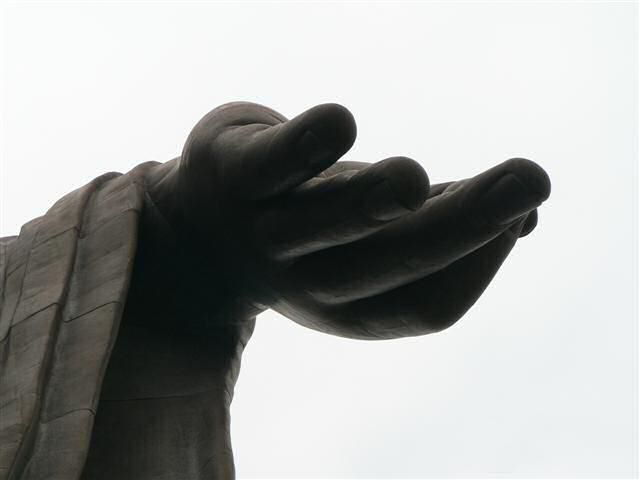 |
Third, the position
of its hands have an important meaning. The left hand's palm, totally
visible, refers to the helpful mind of Buddha(念仏衆生接種不捨
or Nenbutsu-Shujou-Sesshu-Fusha),
as if it was saying: "I will help you. I will show you the path to
Heaven". So, for those who misunderstood this and thought it was asking
for money, you were WRONG. The hand is not asking for anything, the hand
is giving help. I wish it would give money though . . . there is a car I
would like to buy. . . .
|
The right hand |
|
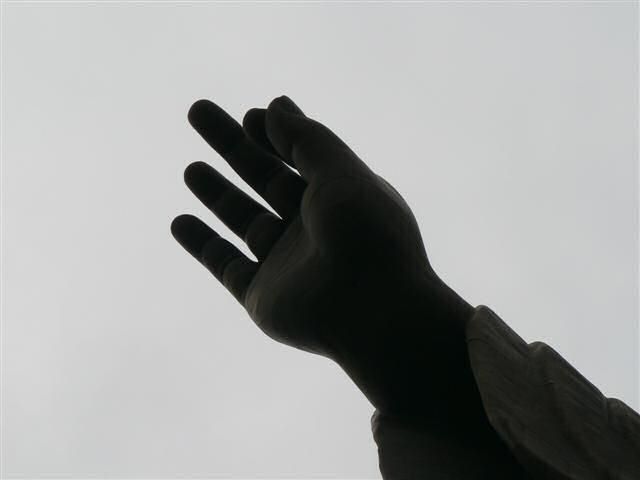 |
Jokes aside, the
right hand is also very interesting and people familiar with the movie
The Lord Of The Ring will surely find a stunning similitude. This hand
forms a circle with the thumb and the index. This refers to the
omnipresence of Buddha. Buddha is everywhere because it can see in every
single direction, just like the eye in the above-mentioned film. Don't
forget the name of the right hand, it is Koushou-Henshou-Jippou-Sekai.
Not easy? Sorry, I thought it was. Here is the Kanji anyway for people
interested in this:
光明編照十方世界.
Did you know that
you can enter inside the Buddha? I am not lying. The Buddha contains
many rooms worth seeing. The first one you can go into is totally dark.
Obscurity in there lasts 50 seconds. A voice tells us in Japanese that
Buddha gives his light through his wisdom to those who are lost, in the
dark side. Buddha leads and gives life. In other words, this room
symbolizes to the dark world (無明の世界 or Mumyou No Sekai).
After this
introduction, you will have full access to the 5 floors inside the
Daibutsu. The World of Infinite Light and Life
(光りの世界
or Hikari No Sekai), the World of
Gratitude and Thankfulness(知恩報徳の世界
or Chion-Houtoku No Sekai),
the World of the Lotus Sanctuary(蓮華蔵世界
or Renge-Zou-Sekai)and the Room
of Mt. Grdhrakuta(霊鷲山の間
or Ryouju-Sen No Ma)A full
description of these floors could take ages. We chose to mention the
World of Lotus Sanctuary. In a circular shape, this floor is filled with
3,300 images of Buddha. It is possible to meet the priest and pray
there. In fact, many families have their own statuette of Buddha there.
Smaller ones can cost 300,000 yen while the bigger ones reach 1 million
yen. The room is all golden. However, the only place with real gold is
where the priest sits. This floor represents the Pure Land.
However the Daibutsu
is not all about Buddha. You have all around beautiful gardens and
flowers and a pond where the fish are very popular among children. The
zoo and the monkey stage close to the Daibutsu provide entertainment to
kids not really involved in spirituality and Japanese culture. The
Daibutsu welcomes about 190,000 visitors a year and is not very famous
yet but its potentiality to attract visitors exists for sure. It is a
nice place to go, surrounded by greenery, easy to access by shuttle bus
from the Southern side of Ushiku station. Access will become easier by
car from December. The new highway will be stopping by really close with
the appearance of a new interchange.
Take a break and go
to the Daibutsu, the only one of its kind. If the weather is fine, this
is surely a good opportunity to visit it for really cheap! We recommend
it!
Entrance fee from
April to November: 500 yen/adult and 300 yen/children for anything but
the inside visit of the Daibutsu. If you want to get inside too: 800
yen/adult and 400yen.
Entrance fee from
December to March: 400 yen/adult and 200 yen/children (no inside visit)
or 700 yen/adult and 400 yen/children (inside visit included)
Free entrance on New
Year and August 15th (from 5 p.m.)
Thank-you so much
to Tananashi-san, who kindly showed us around the Daibutsu
Kỹ thuật vi tính: Hải
Hạnh,
Ðàm
Thanh,
Diệu
Nga,
Tâm
Chánh,
Nguyên
Tâm
Trình bày: Nhị Tường